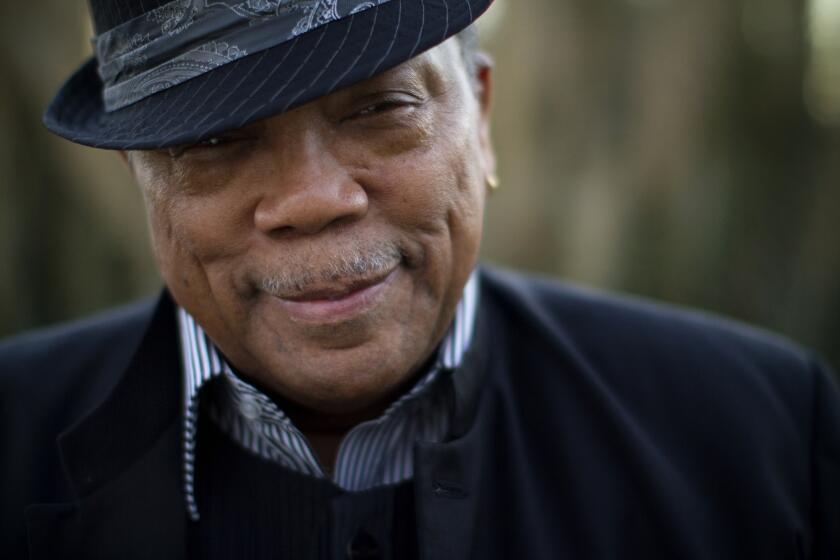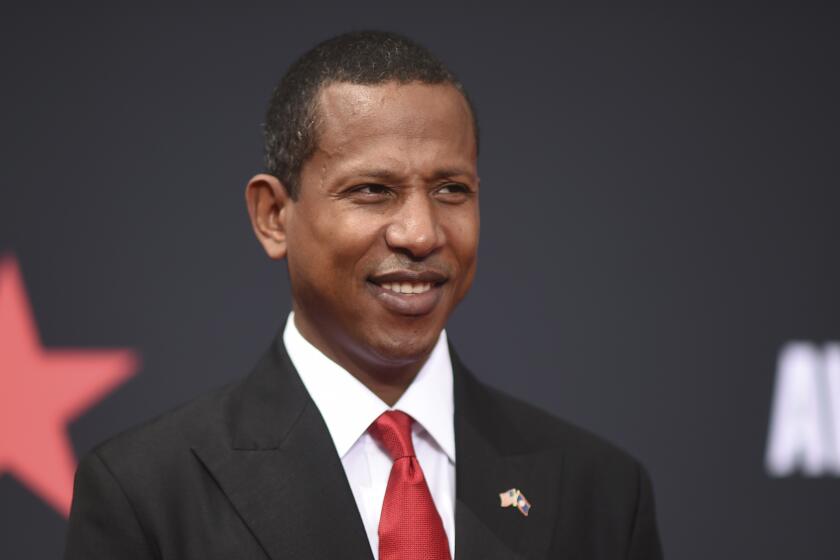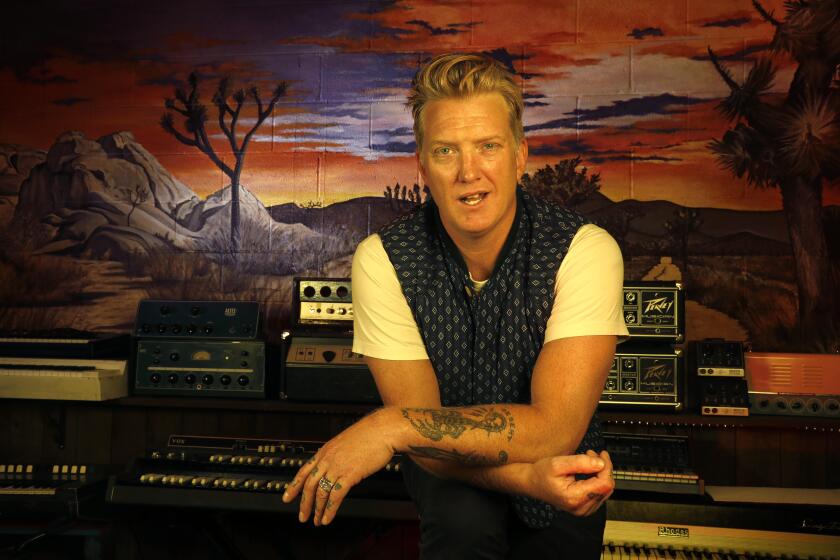POP MUSIC REVIEW : Powerful Sting : Rock: At his San Diego concert, the rock star proved he can shed past trappings and give a powerful performance with a small band and few gimmicks.
SAN DIEGO — Boil the grandiose, production-value fat from many big-name concerts and wave away the illusory smoke, and you’re left with an unimpressive residue of talent. But Saturday, on the last night of his American tour, Sting demonstrated to a sold-out San Diego Sports Arena crowd that a world-class artist can reduce his act to the bare essentials without sacrificing substance. He can even have fun doing it.
The British rock phenom (born Gordon Sumner 39 years ago) was backed by a trio of David Sancious (keyboards), Dominic Miller (guitar) and Vinnie Colaiuta (drums). This band was a high-performance sports car compared to the jazz-accented, eight-piece limos Sting brought along on his last couple of tours.
There were no gigantic video monitors to relay every facial expression and chest-baring striptease, as in Sting’s 1988 show at the arena. The lighting effects were, for the most part, augmentative and unobtrusive. Everywhere were indications that Sting’s “Soul Cages” tour was divergent from past shows in the area of attitude.
Although his every move onstage still elicits the loud approval of the females in the audience, Sting eschewed the overt sexiness exhibited in past outings. In lieu of the unbuttoned buccaneer shirts and harem pants of yesterday, he wore a black T-shirt, black jeans and calf-high black boots. His stage patter was good-natured, mostly uncalculated, schmoozey.
Sting even came out to introduce the middle act on the bill, an African-American vocalist-percussionist who calls himself Vinx. (Concrete Blonde opened the show.) Sting discovered the man in a small club in Santa Monica and signed him to his own Pangaea record label. As an emcee, Sting was deferential to the point of effusiveness.
The entire presentation seemed designed to show Sting in more of a Common Man posture--one closer to that of his early days in the Police than that of the elite artiste who toured in support of his first two solo albums, 1985’s “The Dream of the Blue Turtles” and
1987’s “ . . . Nothing Like the Sun.” If Sting’s legendary ego remains as healthy as ever, its external manifestations were reigned in for this tour.
Happily, for Sting and for his fans, the man’s body of work is strong enough to withstand a contextual paring down. Opening with the funky-jazzy “Jeremiah Blues (Part 1)” from “Soul Cages,” Sting and band quickly established the tone for the evening. On the album, the track has a controlled fire, as though its author had carefully doled out the momentum to ensure a steady supply. In concert, the quartet rode Sancious’ jazzy fills (alternating between his keyboard’s “electric-piano” and “organ” presets) in a more sportive reading.
As a composer, Sting has progressed from a Police-era reliance on guitar-dictated song structures to a point where one cannot imagine his music without keyboards. Sancious has been conversant with fusions of rock with other genres for many years, so perhaps he has more naturally adapted to Sting’s sophisticated brand of rock than did Kenny Kirkland, the jazz-schooled keysman in Sting’s previous tour bands.
While Miller’s guitar work was more than serviceable, and highly respected drummer Colaiuta provided solid-but-pliant timekeeping, Sancious was the band’s point man. This was nowhere more evident than during the concert’s third selection, “Mad About You.”
Sting prefaced the tune from “Soul Cages” with a somewhat uncharacteristically ribald explanation of how it had been inspired “by a story of King David in the Bible.” But Sancious drew out the stately song’s funkier colors with a solo that jumped from rhythmic chording played in a “honky-tonk- harpsichord” preset to sinewy synthesizer improvisation.
Sting would perform all but a couple of the songs from “Soul Cages.” The album leans toward the somber because much of it deals with Sting’s retroactive feelings for his father, an allegedly distant man who died three years ago. The singer employed his usual cheeky humor to mitigate the material’s potential sobering effect on the show.
Following one dad-reflective (if sprightly) tune, “All This Time,” Sting had a man in a sea captain’s uniform bring him a cup of tea (this recalled the Police’s video-displayed, backstage “tea break” in the middle of an early-’80s concert at SDSU’s Aztec Bowl). Then, Sting introduced the shuffling dirge, “Why Should I Cry for You?” by saying: “My dad gave me just one piece of advice: Don’t get married; go to sea. This song’s for him.” At one point in the song, Sting affectingly quoted from Tim Hardin’s “If I Were a Carpenter.”
Prior to performing the Police’s first hit, 1979’s reggae-informed “Roxanne,” Sting mugged as he read silently from a letter that had been tossed onstage by a female fan during a preceding song. “Roxanne” and a later rendition of “Message in a Bottle” got re-workings that placed them somewhere between the Police’s rollicking versions and the more melancholy readings Sting unveiled in his initial solo gigs.
In keeping with his determination to have fun on this tour, Sting tucked a couple of surprises into the song list. One was a wonderful interpretation of Bill Withers’ 1971 hit, “Ain’t No Sunshine.” Considering that Withers’ arrangement of the tune features some permanent-press creases, the fact that this quartet gave it a rhythmically elastic play was further evidence that Sting didn’t rehearse the band to deadly perfection.
Another surprise was a version of Jimi Hendrix’s “Purple Haze,” for which Sancious switched from keyboards to rhythm guitar. The song added a novel touch to the proceedings, but a too-faithful reproduction clouded its purpose in a Sting concert.
Not surprisingly, such Police-identified selections as “Tea in the Sahara,” “Walking on the Moon,” “When the World Is Running Down, You Make the Best of What’s Still Around,” and “Every Breath You Take” elicited ovations from the throng.
Sting returned for a single encore, the lovely South American “mood” piece, “Fragile,” from “ . . . Nothing Like the Sun.” The tune’s delicate texture (featuring Sting on nylon-string guitar) and plaintive message closed the concert, and the tour, on a sweetly solemn note.
That, in itself, indicates that at this point in his career, Sting is more concerned with satisfying his own creative impulses than with playing to expectations.
More to Read
The biggest entertainment stories
Get our big stories about Hollywood, film, television, music, arts, culture and more right in your inbox as soon as they publish.
You may occasionally receive promotional content from the Los Angeles Times.










